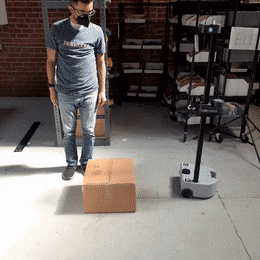Mobile Base Collision Avoidance
Example 3
This example aims to combine the two previous examples and have Stretch utilize its laser scan data to avoid collision with objects as it drives forward.
Begin by running the following command in a new terminal.
roslaunch stretch_core stretch_driver.launch
Then, in a new terminal, type the following to activate the LiDAR sensor.
roslaunch stretch_core rplidar.launch
To set navigation mode and to activate the avoider.py node, type the following in a new terminal.
rosservice call /switch_to_navigation_mode
cd catkin_ws/src/stretch_tutorials/src/
python3 avoider.py
To stop the node from sending twist messages, type Ctrl + c in the terminal running the avoider node.

The Code
#!/usr/bin/env python3
import rospy
from numpy import linspace, inf, tanh
from math import sin
from geometry_msgs.msg import Twist
from sensor_msgs.msg import LaserScan
class Avoider:
"""
A class that implements both a LaserScan filter and base velocity control
for collision avoidance.
"""
def __init__(self):
"""
Function that initializes the subscriber, publisher, and marker features.
:param self: The self reference.
"""
self.pub = rospy.Publisher('/stretch/cmd_vel', Twist, queue_size=1) #/stretch_diff_drive_controller/cmd_vel for gazebo
self.sub = rospy.Subscriber('/scan', LaserScan, self.set_speed)
self.width = 1
self.extent = self.width / 2.0
self.distance = 0.5
self.twist = Twist()
self.twist.linear.x = 0.0
self.twist.linear.y = 0.0
self.twist.linear.z = 0.0
self.twist.angular.x = 0.0
self.twist.angular.y = 0.0
self.twist.angular.z = 0.0
def set_speed(self,msg):
"""
Callback function to deal with incoming LaserScan messages.
:param self: The self reference.
:param msg: The subscribed LaserScan message.
:publishes self.twist: Twist message.
"""
angles = linspace(msg.angle_min, msg.angle_max, len(msg.ranges))
points = [r * sin(theta) if (theta < -2.5 or theta > 2.5) else inf for r,theta in zip(msg.ranges, angles)]
new_ranges = [r if abs(y) < self.extent else inf for r,y in zip(msg.ranges, points)]
error = min(new_ranges) - self.distance
self.twist.linear.x = tanh(error) if (error > 0.05 or error < -0.05) else 0
self.pub.publish(self.twist)
if __name__ == '__main__':
rospy.init_node('avoider')
Avoider()
rospy.spin()
The Code Explained
Now let's break the code down.
#!/usr/bin/env python3
Every Python ROS Node will have this declaration at the top. The first line makes sure your script is executed as a Python3 script.
import rospy
from numpy import linspace, inf, tanh
from math import sin
from geometry_msgs.msg import Twist
from sensor_msgs.msg import LaserScan
You need to import rospy if you are writing a ROS Node. There are functions from numpy and math that are required within this code, thus linspace, inf, tanh, and sin are imported. The sensor_msgs.msg import is so that we can subscribe to LaserScan messages. The geometry_msgs.msg import is so that we can send velocity commands to the robot.
self.pub = rospy.Publisher('/stretch/cmd_vel', Twist, queue_size=1)#/stretch_diff_drive_controller/cmd_vel for gazebo
This section of the code defines the talker's interface to the rest of ROS. pub = rospy.Publisher("/stretch/cmd_vel", Twist, queue_size=1) declares that your node is publishing to the /stretch/cmd_vel topic using the message type Twist.
self.sub = rospy.Subscriber('/scan', LaserScan, self.set_speed)
Set up a subscriber. We're going to subscribe to the topic scan, looking for LaserScan messages. When a message comes in, ROS is going to pass it to the function set_speed() automatically.
self.width = 1
self.extent = self.width / 2.0
self.distance = 0.5
self.width is the width of the laser scan we want in front of Stretch. Since Stretch's front is pointing to the x-axis, any points with y coordinates further than half of the defined width (self.extent) from the x-axis are not considered. self.distance defines the stopping distance from an object.
self.twist = Twist()
self.twist.linear.x = 0.0
self.twist.linear.y = 0.0
self.twist.linear.z = 0.0
self.twist.angular.x = 0.0
self.twist.angular.y = 0.0
self.twist.angular.z = 0.0
Allocate a Twist to use, and set everything to zero. We're going to do this when the class is initiated. Redefining this within the callback function, set_speed() can be more computationally taxing.
angles = linspace(msg.angle_min, msg.angle_max, len(msg.ranges))
points = [r * sin(theta) if (theta < -2.5 or theta > 2.5) else inf for r,theta in zip(msg.ranges, angles)]
new_ranges = [r if abs(y) < self.extent else inf for r,y in zip(msg.ranges, points)]
This line of code utilizes linspace to compute each angle of the subscribed scan. Here we compute the y coordinates of the ranges that are below -2.5 and above 2.5 radians of the scan angles. These limits are sufficient for considering scan ranges in front of Stretch, but these values can be altered to your preference. If the absolute value of a point's y-coordinate is under self.extent then keep the range, otherwise use inf, which means "no return".
error = min(new_ranges) - self.distance
Calculate the difference of the closest measured scan and where we want the robot to stop. We define this as error.
self.twist.linear.x = tanh(error) if (error > 0.05 or error < -0.05) else 0
Set the speed according to a tanh function. This method gives a nice smooth mapping from distance to speed, and asymptotes at +/- 1
self.pub.publish(self.twist)
Publish the Twist message.
rospy.init_node('avoider')
Avoider()
rospy.spin()
The next line, rospy.init_node(NAME, ...), is very important as it tells rospy the name of your node -- until rospy has this information, it cannot start communicating with the ROS Master.
Note
The name must be a base name, i.e. it cannot contain any slashes "/".
Instantiate class with Avioder().
Give control to ROS with rospy.spin(). This will allow the callback to be called whenever new messages come in. If we don't put this line in, then the node will not work, and ROS will not process any messages.